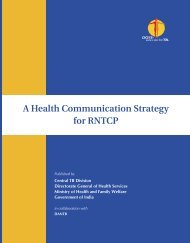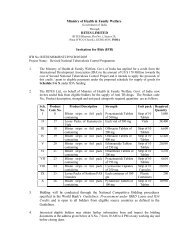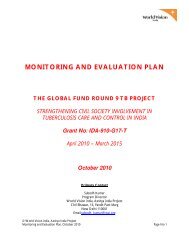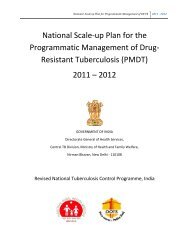RNTCP Annual Report 2012 - TBC India
RNTCP Annual Report 2012 - TBC India
RNTCP Annual Report 2012 - TBC India
You also want an ePaper? Increase the reach of your titles
YUMPU automatically turns print PDFs into web optimized ePapers that Google loves.
in the year 2009, the prevalence of TB in <strong>India</strong> was<br />
estimated to be 249 per 100,000 populations, and the<br />
mortality due to TB is 23 per 100,000 populations [WHO<br />
Global TB <strong>Report</strong>, 2010]. These estimate are derived<br />
based on mathematical and have its own inherent<br />
limitations. Government of <strong>India</strong> has undertaken<br />
nationally representative <strong>Annual</strong> Risk of TB Infection<br />
survey and TB Prevalence surveys in 7 sites of the country.<br />
The results of these surveys will be available during the<br />
mid 2011 and are expected to provide more realistic<br />
population based estimates. As far as the progress<br />
towards indicator 24 is concerned, the country has<br />
achieved the targets on case detection and treatment<br />
outcomes, in the year 2007 onwards (after whole country<br />
coverage).<br />
Impact of Other Determinants of TB Burden:<br />
WHO has suggested that the expected effect of<br />
improved diagnostic and treatment services may be<br />
negated by an increase in the prevalence of risk factors<br />
for the progression of latent TB to active disease in<br />
segments of the population which may tend to increase<br />
incidence despite reductions in transmission achieved<br />
under the Stop TB strategy. Broadly described, these risk<br />
factors may be biomedical (such as HIV infection,<br />
diabetes, tobacco, malnutrition, silicosis, malignancy),<br />
environmental (indoor air pollution, ventilation) or<br />
socioeconomic (crowding, urbanization, migration,<br />
poverty).<br />
The impact of these other determinants on TB<br />
epidemiology in <strong>India</strong> has yet to be fully understood.<br />
The most recent estimates of the global burden of<br />
diabetes mellitus (DM) come from the 2011 Diabetes<br />
Atlas of the International Diabetes Federation. Diabetes<br />
has been shown to be an independent risk factor for<br />
tuberculosis in community based study from South <strong>India</strong><br />
and multiple studies globally. Modeling has suggested that<br />
diabetes accounts for 14.8% of all tuberculosis and 20.8%<br />
of smear-positive TB. In 2011, there were an estimated<br />
366 million cases of DM globally, and by 2030 it is<br />
expected that this number will have risen to 552 million.<br />
80% of people with DM live in low- and middle-income<br />
countries and 50% of all people with DM (183 million)<br />
are undiagnosed. It is estimated that DM caused 4.6<br />
million deaths in 2011. As a consequence of urbanization<br />
as well as social and economic development, there has<br />
been a rapidly growing epidemic of diabetes mellitus<br />
(DM) in <strong>India</strong>. Available data suggest that an estimated<br />
11% of urban people and 3% of rural people above the<br />
age of 15 years have DM. Among them about half in<br />
rural areas and one third in urban areas are unaware that<br />
they have DM. Most recent estimates from the<br />
International Diabetes Federation put the number of<br />
persons with diabetes mellitus at 61.3 million (10% of<br />
the adult population), with a further 77 million having<br />
impaired glucose tolerance.<br />
While the HIV epidemic in <strong>India</strong> appears to have<br />
peaked, the total number of persons living with HIV/<br />
AIDS remains high, and with time the level of immune<br />
deficiency and TB vulnerability may increase.<br />
Malnutrition remains highly prevalent in <strong>India</strong>, and will<br />
remain a significant factor for years to come. <strong>India</strong> is<br />
urbanizing at a fantastic pace, bringing larger numbers<br />
of persons into urban areas with documented higher<br />
rates of TB transmission. Tobacco use is highly prevalent<br />
in <strong>India</strong>, and has been suggested to be a potent<br />
contributor to TB-related mortality. The confluence of<br />
these and other risk factors could well influence the TB<br />
epidemiology in <strong>India</strong>. Some of the factors are<br />
described below.<br />
Population Attributable Fraction -risk factors<br />
for progression to disease:<br />
Relative<br />
risk for<br />
active TB<br />
disease<br />
PAF = [P*(RR-1)] / [P*(RR-1)+1]<br />
Sources: Lönnroth K, Castro K, Chakaya JM, Chauhan<br />
LS, Floyd K, Glaziou P, Raviglione M. Tuberculosis<br />
control 2010 -2050: cure, care and social change. Lancet<br />
2010 DOI:10.1016/s0140-6736(10)60483-7.<br />
Drug Resistant Tuberculosis:<br />
Tuberculosis Epidemiology - <strong>India</strong><br />
Weighted<br />
prevalence<br />
(adults 22<br />
HBCs)<br />
Population<br />
Attributable<br />
Fraction<br />
(adults)<br />
HIV infection 20.6/26.7* 0.8% 16%<br />
Malnutrition 3.2** 16.7% 27%<br />
Diabetes 3.1 5.4% 10%<br />
Alcohol use 2.9 8.1% 13%<br />
(>40g / d)<br />
Active smoking 2.0 26% 21%<br />
Indoor Air 1.4 71.2% 22%<br />
Pollution<br />
Multidrug Drug Resistant Tuberculosis (MDR-TB):<br />
The Global Project on anti-tuberculosis drug resistance<br />
surveillance was launched in 1994 with two key objectives:<br />
(i) to estimate the magnitude of drug resistance; and (ii)<br />
to monitor trends in drug resistance. Since 1994,<br />
significant efforts to promote the monitoring of drug<br />
resistance through national surveys and continuous<br />
surveillance based on diagnostic testing have been made,<br />
9






